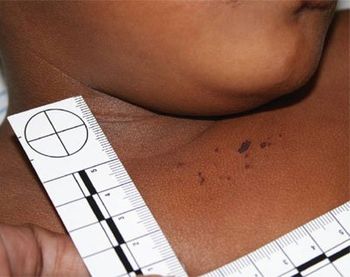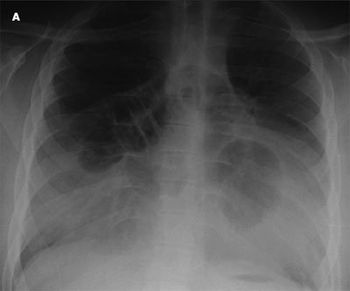
A short window of action exists for the newborn with suspected sepsis. With little time and less-than-perfect lab studies, are CRP values the added clue you need to arrive at a diagnosis?

A short window of action exists for the newborn with suspected sepsis. With little time and less-than-perfect lab studies, are CRP values the added clue you need to arrive at a diagnosis?

CA and NY nurses seek H1N1 protection; nurse-doctor teamwork shown to save money; formation of national nursing union faces obstacles; nurses' Internet use studied

The high spirits and optimism of a patient receiving her latest in a long series of chemotherapy treatments provides perspective to a stressed-out nurse, and an enduring lesson in what truly matters.

Patients may be overwhelmed with the multiple lifestyle changes that control of hypertension requires. RN's care guide will help them understand why each step toward normal blood pressure is so important for long-term health.

After receiving a negative diagnosis, patients often are too emotional to understand or even hear you explain their condition. Help give your patients a clearer picture of what lies ahead with our tips for sensitive engagement and education.

Because of the presence of unusual skin findings, a 3-year-old African American girl was evaluated for possible child abuse. The father, the primary guardian, reported that his daughter had returned home from her mother's residence 2 days before-a day earlier than planned. According to the father, the child was crying and had skin lesions, which initially appeared white and then darkened over the course of the next day or two.

A 16-year-old boy with Down syndrome was referred for evaluation of nonspecific symptoms, including difficulty in breathing on standing up from a sitting position, dizziness, frequent abdominal pain, and diarrhea after ingesting fatty foods and milk. He had intermittent asthma exacerbations for which he occasionally used a β-agonist. He had no history of trauma, surgery, or allergies.

Impoverished parents who spank their one-year-old children may encourage aggressive behaviors and cognitive delays in their children for the next two years.

The American Academy of Pediatrics (AAP) recently doubled the amount of vitamin D that it recommends all infants, children, and adolescents receive each day-from 200 to 400 IU. Also new is the academy's recommendation that vitamin D supplementation begin as soon after birth as possible. Supplementation is recommended in infants who do not receive 400 IU per day from formula.

For years, pediatricians have discussed with parents the important role that reading to their children plays in the development of language skills. We have encouraged talking to children about things around them, describing objects and events, and telling stories.

My teenaged patient has celiac disease and type 1 diabetes, both of which are well controlled. The patient’s mother is concerned that her son’s risk of a bowel malignancy or other celiac-related complication later in life would be significantly increased if he ingested small amounts of gluten for 5 to 7 days while at camp or on a church trip. As a result, the youngster is not allowed to participate in such outings, since it is not always possible to pack one’s own food for such trips and the available food options are usually limited.

Prune belly syndrome is a rare condition, classically referred to as a triad of abdominal wall musculature deficiency, bilateral cryptorchidism, and other urological abnormalities, although the clinical presentation can vary. A case history here.

Certain birth control pills seem to inhibit growth of bone mineral density in adolescent girls, a new study shows.

The FDA approved the H1N1 influenza vaccines from four different companies, ensuring a robust stockpile for the upcoming fu season.

A total of 38 states will receive $38 million in incentives from HHS because of their efforts to raise the number of foster care-related adoptions.

To avoid retesting and possible antibiotic overuse, follow these four tips when drawing blood for a suspected case of community-acquired pneumonia.

Codeine use for child tonsillectomies is being scrutinized after the surprise death of a Canadian child whose system metabolized codeine into morphine at an abnormally high rate.

As many as 12% of subarachnoid hemorrhages are misdiagnosed at the ED, leading clinicians to look past the classic symptoms to CT scans and lumbar punctures for proof.

The death of a Calif. nurse from H1N1 flu sparked both protests by fellow nurses as well as concern over the issue of healthcare worker safety during a flu pandemic.

Winchester, VA's Valley Health has established a community case management program to prevent hospitalizations and ED visits for frail patients who live alone.

How does a vaccine supply get doubled overnight? By finding out that the second dose isn't needed to get efficacy.

In the wake of the ongoing H1N1 flu outbreak and the start of the latest round of seasonal flu, the word to parents of all children is to vaccinate sooner than later.

Gardasil, the human papillomavirus vaccine approved for females, may soon be approved for males as well.

Parents who start early in building the concept of relational connections or affiliations with infants can assist in fostering altruistic behaviors down the road, new research shows.

For CS Mott Children's Hospital new poll on schools, appropriately enough, it put out a report card.

The FDA has approved a new type of drug, an alpha-2A adrenergic receptor agonist, to treat ADHD in children as young as six.

A large study found that the mortality rates for home births were actually better than those in a hospital.

Asthma is the most prevalent chronic disease in children. In the United States, asthma affects approximately 1.4 million children younger than 5 years and causes frequent activity limitations and hospitalizations.

Three cabinet offices have allied to fight the H1N1 virus, and they?ve recruited Elmo the Muppet to help.

Follow the treatment and education of a newly diagnosed type 2 diabetes patient: taking a case history, making a diagnosis, and teaching the patient how to monitor and control blood sugar.